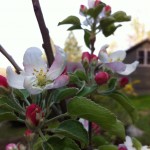 Wondering “How can I find Mushrooms?” Look no further!
Wondering “How can I find Mushrooms?” Look no further!
Enjoy this Guest Post from Author and Mushroom Hunter Jared White from
Adventuresinmushrooming.blogspot.com:
So you want to start mushrooming, but you don’t want to poison yourself?
That sounds pretty reasonable!
Everyone should start with the easiest mushrooms to identify, in the woods.
The Foolproof 4
- Morels
Need I say more?
Strike up a wild mushroom conversation with any random person off the street and 9.99 times out of 10 they will mention morel mushrooms in the first sentence.
They were my gateway shroom.
These are the big wrinkly cones that emerge en masse as soon as winter truly gives up the ghost. Mushroomers greedily keep their morel sites secret only passing on to relatives on their death bed. I had to wander aimlessly all over my area just to stumble upon them.
Learn their habitats and favorite trees or torture an old shroomer, I’ll leave it up to you.
In the kitchen, soak in water a bit to clear debris and bugs, dry for preservation and long term use, or batter fry them and wolf them down. Good in soups and gravies or sautéed on decadent burgers or steaks. Caution, false morels (Gyromitra) are lumpy weird things not really morel looking but look them up and compare your finds anyway.
Mushroomers greedily keep their morel sites secret only passing on to relatives on their death bed.
2. Chanterelle
Here we have the gourmet apricot-scented chanterelle.
These things were carpeting the forests in my area this early summer. It’s amazing that something that garnishes high priced platters at five star restaurants is found in abundance in the woods.
I was so excited to find them but after weeks of eating them I honestly got a little tired of the flavor. I still have a gallon bag in my freezer awaiting any slight craving.
I even soaked a few in vodka to add a splash of that interesting flavor to cocktails.
Main distinguishing markers are the “false gills” on true chanterelles as compared to “true gills” of the false chanterelle (go ahead, read that again).
The chanterelle’s “false gills” are really just disorganized wrinkly folds and not regularly divided gills, sometimes they are even completely absent as with the smooth chanterelle.
Also similar to the untrained eye are Jack O’lantern mushrooms (Omphalotus illudens). Look those up so you can be sure to avoid them and in turn avoid a miserable day or two the bathroom or worse.
In the kitchen, wash under the faucet and gently brush off debris, they’re notoriously dirty, use in soup or sautéed toppings, even ice cream or liquor additives. There’s many recipes to be found online but this creamy chanterelle soup recipe (http://www.seriouseats.com/recipes/2014/01/creamy-chanterelle-soup-recipe.html) may just be the best thing I’ve ever cooked (you’re welcome).
3. Chicken of the Woods
Chicken of the Woods is a good one to feed your picky mushroom hating friends.
These are large (sometimes HUGE) shelves growing directly on wood, bright orange with sulfur yellow pore surface.
They’re hard to miss and nothing looks like them.
If you’re extra lucky you’ll find the white species, L. cincinnatus. Slightly differing from the sulfur colored pores, L. cincinnatus has bright white pores and is typically on the ground at the foot of trees (growing from buried wood). It’s usually softer and plumper than the sulfur shelf variety.
In the kitchen, substitute for chicken in any dish, seriously, it cooks, tastes, and feels like chicken!
I love to beer batter, fry, and toss with buffalo sauce. It’s a big hit at dinner parties. One word of caution, avoid Chicken of the Woods growing on coniferous trees, it has had more frequently reported cases of gastronomic distress. That would definitely put any wild mushroom skeptic’s guard up permanently.

4. Giant Puffball
The giant puffball looks exactly what it sounds like.
Its as if a small moon dropped from the sky and rooted into the forest floor.
I’ve seen them softball sized to slightly larger than a basketball. When you harvest make sure it’s firm and white. If you see a brown one make sure you give it a good kick, you know, to propagate the spores, also it’s super fun.
In the kitchen, peel the skin off and slice in half to make sure they are totally white throughout. Toss any browning (or greening) spots. It’s pretty versatile, you can substitute for tofu in any recipe or grill up a big thin slice as a pizza crust. There’s much more, ask Google for recipes.
Be careful, once you catch the bug you may end up with a shelf like this in your kitchen, much to your spouse’s chagrin!
 Thanks Austin for letting me share the mushroom love!
Thanks Austin for letting me share the mushroom love!
Visit my blog at Adventuresinmushrooming.blogspot.com to follow my further adventures and learn to identify more mushrooms along with me!
- Jared White is a bearded dad, environmentalist, shroomer, forager, rock climber, photographer, future farmer, and native Arizonan in SW Pennsylvania. Follow him at Adventuresinmushrooming.blogspot.com




Hi,
I hope you are doing well !!!
We have gone through your blog posts and it’s really good, just wanted to know how we can share our blog post on your website as guest blogger.
I would appreciate your kind response and let me know how I can move on ahead.
Please find attached my content for guest Blogging, kindly review and post in you guest blogging site.
Regards,
Earths Tongue
I remember seeing a list of mushrooms many years ago called “the foolproof five.” In addition to those mentioned here (and elsewhere), the shaggy mane mushroom was also mentioned. Any reason to avoid this?